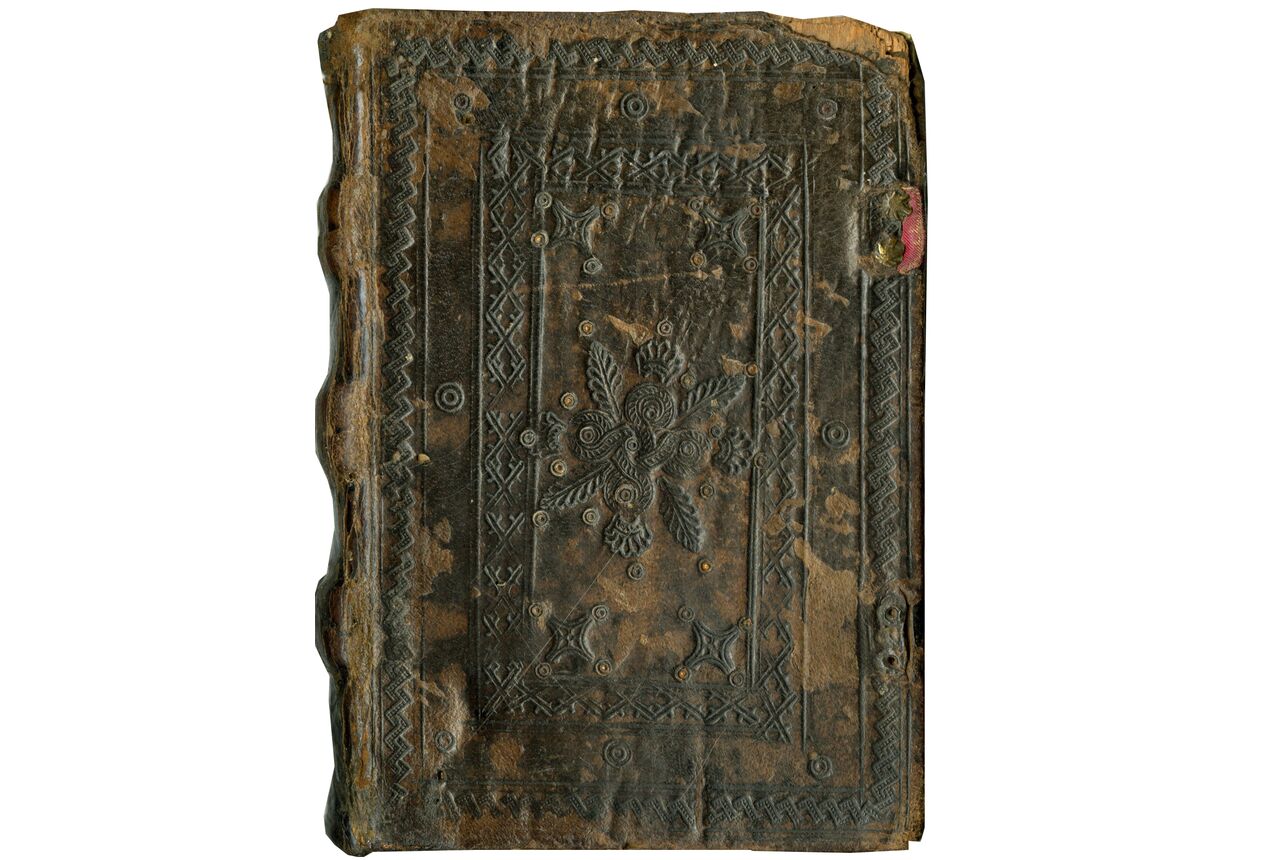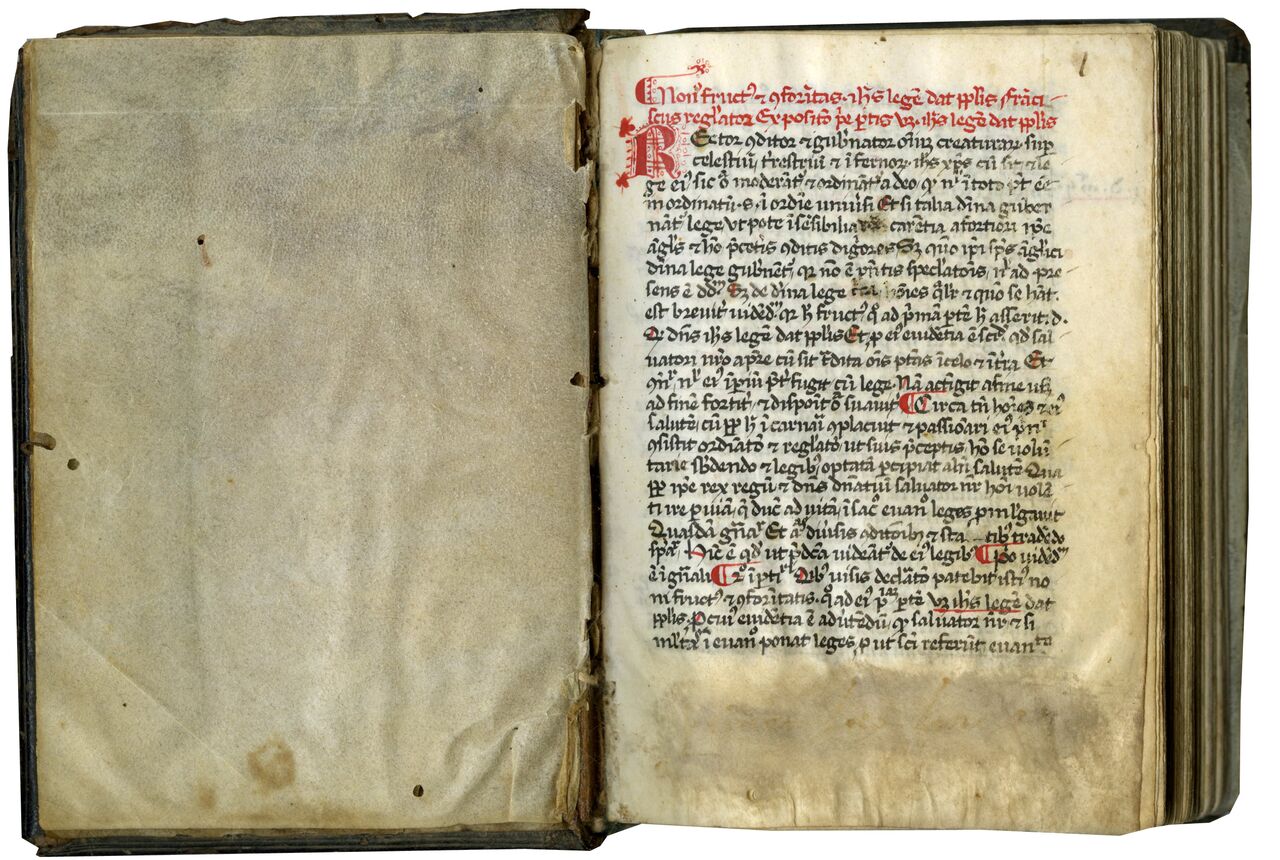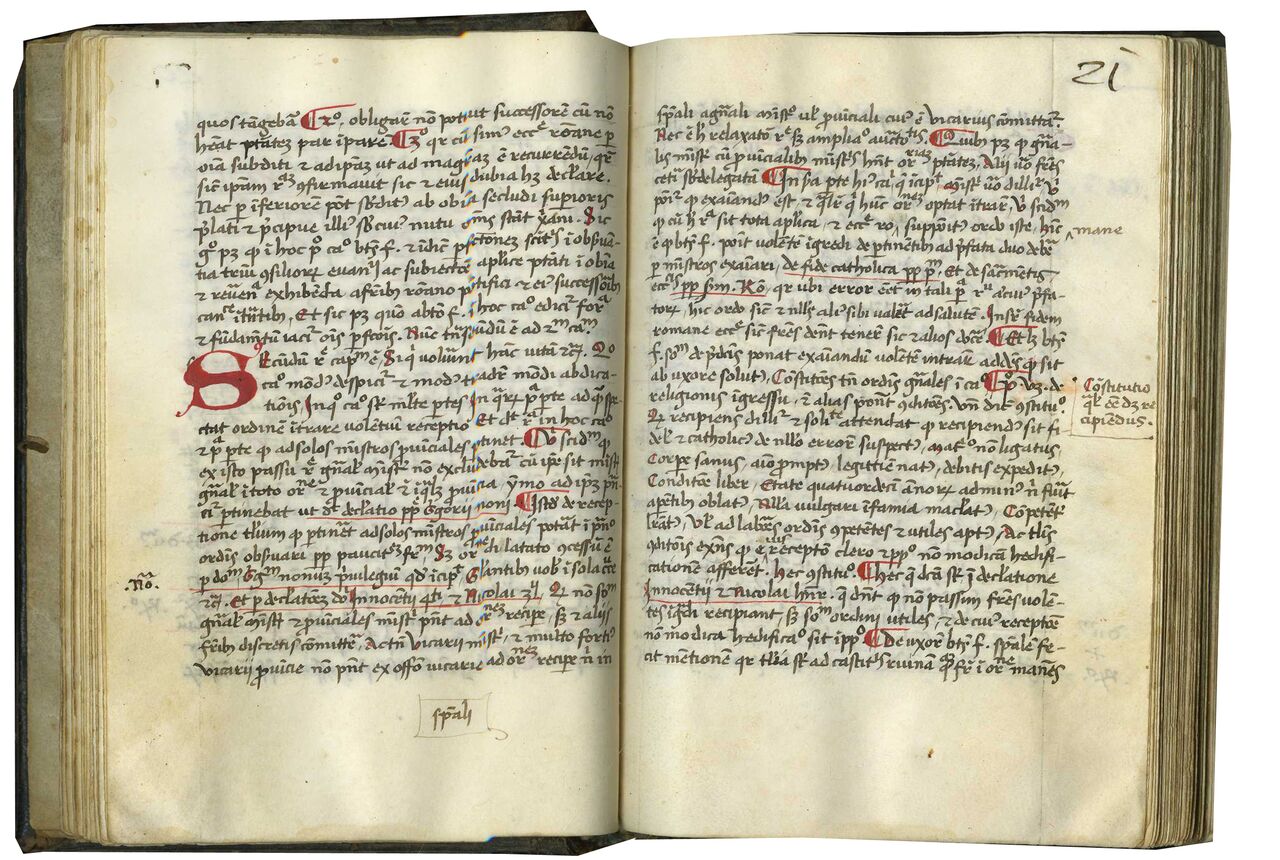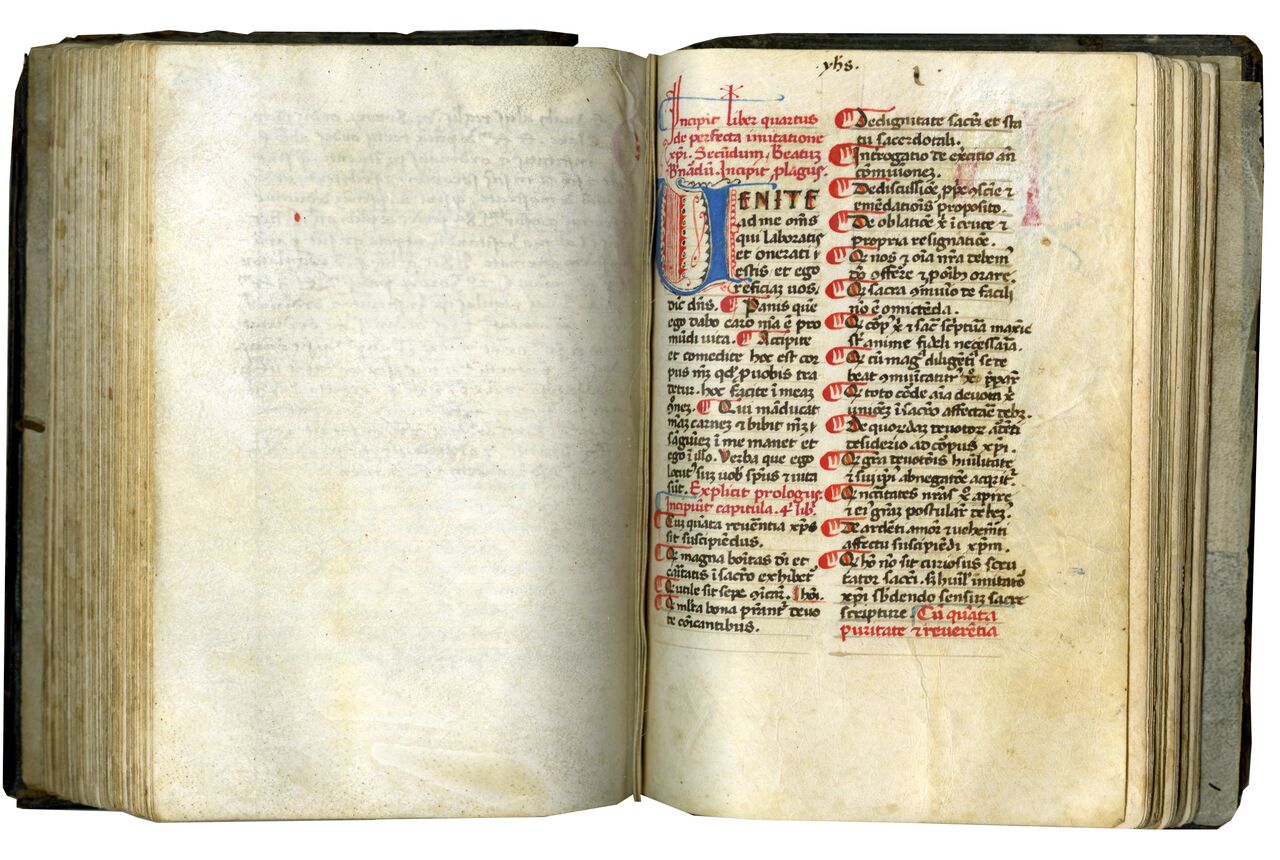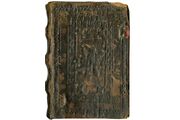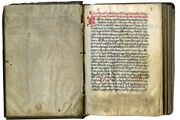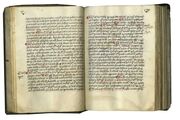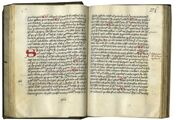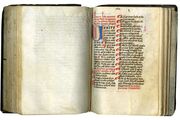i + 109 + i leaves (i-vii10 + viii5 [five leaves cancelled after f. 75 with no loss of text] + ix-x12 + xi10), in octavo, early modern foliation in black ink, top, right, outer corner, as ff. 1-75 (hereafter A) and 1-29 (hereafter B), blank leaves at end unfoliated, ff. 1-75 on parchment of moderate to high quality, finely pumiced, ff. 76-109 on a mixture of moderate quality parchment and paper, with two watermarks present in the paper stocks: (i) a cross pattée within a circle, known from just thirteen examples (Piccard-Online nos. 125759-72), all from the period 1460-72, and all but two from Italy (ii) an unidentified mark on a single leaf of paper in small quarto, visible at f. B 29, (justification, ff. A 1-75, 95 x 70 mm. and ff. B 1-29, 95 x 65 mm.), written by five main hands: (i) ff. A 1-2v, a semitextualis formata in red and black on 26 ruled lines, (ii) ff. A 2v-75, a hybrida libraria/cursiva in black on 26 ruled lines, (iii) ff. B 1ra-16ra, a semitextualis formata/libraria in red and black on 31 ruled lines in two columns, (iv) ff. B 16ra-17rb, a semitextualis libraria in red and black on 30 ruled lines in two columns, (v) ff. B 17va-29rb, a semitextualis formata/libraria in red and black on 31 ruled lines in two columns, the entry “franciscus uir catolicus” in an early modern script on the otherwise blank final verso, seven-line initials in blue and red on ff. B 1, 1v, 5, four- and five-line initials in blue and red on ff. B 3, 4, 6, 7 (twice), 8 (twice), 9, 10, 11v, 12v, 13, 13v, 14, 14v, and 15; two-, three-, and four-line red initials, rubrics and underlining throughout, ff. 75v and all leaves after f. B 29v inclusive (i.e. ff. 104v-109v of the complete volume) are blank, in good condition, text worn on ff. B 1v and 12. Bound in a late fifteenth-century Italian blind-stamped brown leather binding, over wooden boards, somewhat damaged by woodworm, sewn on three cords with remnants of blue endbands, clasps removed, remnant of upper clasp on front fore-edge visible, parchment pastedowns, originally blank. Dimensions (binding) 142 x 100 mm., (book block) 135 x 90 mm.
This small-format Franciscan miscellany, in a contemporary blind-stamped binding, includes an excerpt from Bartolomaeus de Rinonico, a classic and rare Franciscan text by an Italian friar, and Book IV of the great Imitatio Christi, evidence of its dissemination into Italy and readership by Franciscans. The Italian translation of a text on the Mass, known in only one other manuscript, and the text on the Divine Office at Septuagesima, perhaps unique to this manuscript, are of particular importance and the miscellany warrants further study for its unusual contents.
Provenance
1. Written in the third quarter of the fifteenth century in Central Italy as suggested by the evidence of the script, watermarks, binding and early provenance.
Belonged to the Franciscan friary of Lanciano in the province of Chieti in Southern Italy, from a brother Thomas of Lanciano: contemporary inscription in Italian on rear flyleaf, verso, “Questo libro sie dello loco de lanzano lo quale libro fo de frate tomasso de lanzano”, with the later addition in Latin “et pertinet ad loco eius.” Another inscription in the lower margin of f. 1 has been erased, but “pertinet loco Lan”, remains visible. The description of the institution as a “place” (lat. locus) is typically Franciscan. This, taken together with the obviously Franciscan content of the first and longest text, makes it certain that this manuscript was from the Franciscan friary (and not any other institution) in Lanciano, the bequest of an otherwise unknown brother named Thomas (on this friary, although without consideration of its library, see Marciani, 1945/46). The Franciscan church in Lanciano was built on the site of the church of St. Legontian, the location of the Eucharistic miracle in the eighth century where the consecrated Host and wine were changed into actual flesh and blood. The relics of this miracle preserved in the Franciscan church have made it an important pilgrimage site.
The codex consists of two production units bound together, with the break obvious between the eighth and the ninth quires. These were originally conceived as separate units: the division into two columns and the style of the penwork initials using blue ink in the second unit makes it quite different in character to the first. The presence of multiple hands in both units, though none is shared between them, suggests that both are products of a scriptorium. All hands have a strongly Italian aspect. Whether either or both was produced in the Franciscan friary in Lanciano is unknown, but it is certainly a possibility. The watermark dating of the paper stocks in the second production unit gives a certain date, conservatively expressed, of 1460-75, and the first production unit is likely to be of similar date. The palaeography of the scripts is entirely consistent with a dating to the third quarter of the fifteenth century. At this time, Lanciano was a center of the international book trade and the site of the most important Italian book fair, hosted biannually in this strategically located city (Nuovo, 2013, pp. 308-10).
2. Private European Collection.
Text
I.
ff. A 1-75, Nonus fructus et conformitas. Ihesus legem dat populis Franciscus regulator Expositio prime partis videlicet ihesus legem dat populis, incipit, “REctor conditor et gubernator omnium creaturarum supercelestium terrestrium et infernorum ihesus christus cum sit et lege eius sic omnia moderantur et ordinantur a deo quod nihil in toto potest esse inordinatum scilicet in ordine uniuersi …Vnde ad instar trium ecclesiarum a beato F[rancisco] reparatorum et uocem ter sibi factam a christo e cruce de reparatione materialis ecclesie. Tres ordines et regulas instituit in orbe et ecclesia militante et ordinauit sicut patet ad oculum omnibus christicolis Ad laudem christi. Amen”; [f. 75v, blank];
Bartolomeus de Rinonico, De conformitate vitae beati Francisci ad vitam domini Ihesu, extract: liber I, fructus 9. The enormous De conformitate, the modern edition of which runs to well over one thousand large pages (PP. collegii S. Bonaventurae, 1906-12), was written by the friar Bartolomeus de Rinonico from Pisa (d. 1401) in the years 1385-90. Because of its comprehensive sources, and the details it includes on the members and geographical organization of the order known to its author, historians of the Franciscan Order have turned to it as an indispensable source on the first 150 years of the history of the order. It drew on more or less the entire Franciscan literary output up to that point – biography, hagiography, history, legislation, and contemplative writing – in order to demonstrate, across its three books, the exact conformity of the life of St Francis (and by implication, of the friars in his Order) to the life of Christ. Despite its importance, and its circulation in numerous manuscripts in the late medieval period, both as a complete work and in excerpt, there is no modern census of the surviving manuscripts, or study of its transmission (the edition was based on twelve manuscripts; the editors did survey other manuscripts, and evidence of its ownership, but their work is now almost a century old). It was first printed in 1510. Its fame turned into notoriety in the course of the sixteenth century, when Martin Luther’s pupil Erasmus Alberus published a satirical parody of it in 1542, to which Luther himself contributed the preface.
The work is structured around the image of a fruit-bearing tree, and the excerpt presented here is the ninth “fruit” from the first book (vol. 1, pp. 364-457 in the critical edition). Its prologue establishes, in minute detail, the laws that Christ instituted, and Christ’s legislative role is compared to Francis’s role as the author of a monastic rule. Each of the following twelve chapters then elaborates a different aspect of the Franciscan rule: the first, that it was granted miraculously; the second, that it was instituted by Christ himself; the third, that it is grounded upon Scripture, and so forth. The fifth and longest chapter, which alone constitutes about half of the ninth “fruit”, is a comprehensive commentary on the entire Rule. This gives the excerpt the character of a free-standing work. It was often transmitted as such, sometimes entitled as a Declaratio or Expositio regulae. In 1912 the editors noted eight manuscripts with this excerpt in the Latin original, three of an Italian translation, and six early modern editions (see vol. 2, pp. lxxi-lxxv). For an introduction to this voluminous and difficult work, see Erickson, 1972, pp. 253-74; see also Online Resources, Franciscan Authors website, and Manselli).
II.
ff. B 1-16, Incipit liber quartus de perfecta imitatione christi. Secundum Beatum Bernardum. Incipit prolagus [sic], incipit, “UENITE ad me omnes qui laboratis et onerati estis et ego reficiam uos. dicit dominus. Panis quem ego dabo caro mea est pro mundi uita. Accipite et comedite hoc est corpus meum quod pro nobis tradetur. hoc facite in meam commemorationem …. Nec est inuestigatio mirabilium operum eius. Si talia essent opera fidey ut facile ab humana ratione caperentur. non essent in ineffabilia nec mirabilia dicenda. finis”;
Thomas a Kempis (Thomas van Kempen), De imitatione Christi, liber IV. The fourth of the four books of Thomas’s De imitatione Christi, here attributed to Bernard of Clairvaux, corresponds to the text as ed. Pohl, 1904, pp. 90-138. The textual transmission of this treatise, the medieval bestseller par excellence, runs to over 770 manuscripts in Latin and most European vernaculars, and no less than 76 incunable editions (for these data and literature on the transmission, see the entry in the Verfasserlexikon). The fourth book is an essentially independent treatise on the Eucharist, and consequently was often transmitted independently. The individual chapters are written in the persons of Christ (the vox dilecti) and of the individual believer (the vox discipuli), though are not formed strictly into a dialogue: for a discussion of the content, see Caspers, 1993, pp. 93-124.
ff. B 16-17, Speculum compositum per beatam Agustinum de dignitate sacerdotum. Vnde ita dicit, incipit, “O VENERANDA sacerdotum dignitas in quorum manibus filius dei uelut in utero uirginis incarnatur. O felices sacerdotes si sacerdotaliter uisseritis. O celeste misterium quod per uos pater et filius et spiritus sanctus tam mirabiliter operatur…ad meritum et ad veniam. Per dominum”;
Pseudo-Augustine, De dignitate sacerdotum; this short treatise on the worthiness of priests and of the Eucharist begins with a powerful statement that priests are worthy because Christ is born in their hands (i.e. at the consecration of the host) just as he was in the Virgin’s womb. This text was quite widely circulated in the later Middle Ages, with over fifty known manuscripts, and was printed in three incunable editions (GW 02947, 0294705N, and 02948). The ascription to Augustine is entirely spurious: the little text is actually of twelfth-century origin, closely related to – and most likely derived from – the famous Stella clericorum, c. 16-17 (ed. Reiter, 1997, pp. 40-42: see note to c. 16 at pp. 40-41).
ff. B 17v-21v, De officio et tempore septuagesime, incipit, “DIcendum est. Quod septuagesima et eius tempus. Quo filii israel steterunt in babillonia septuaginta annis. Et sic stantibus in tristitia et dolore dimiserunt cantica letitie dicentes… cum gloria iudicatur in uos et mortuo et speculum per ignem, Amen ”;
This short Latin treatise, which is otherwise unidentified, explains the origin and meaning of the divine office for the feast of Septuagesima, which falls on the ninth Sunday before Easter. The Babylonian Captivity, mentioned at the start here, is said to have lasted for seventy years, and the Latin septuagesima means “seventy”, although the feast of Septuagesima falls seventy days before Easter only approximately and by counting in a certain way.
ff. B 22-29, incipit, “CHy uole andare allo sacramento della eucaristia deue examinare la consciencia sua et se uede se essere in peccato mortale ia commisso / o / uero essere in proposito de commetterlo. Et in tale stato pellia lo sacramento pecca mortalmente. per la inreuerentia chi fa allo sacramento… non se trova[?] derasione;” [ff. 29v, and five following leaves, blank].
Pseudo-John of Capistrano, Animadversiones circa sacrosanctum missae sacrificium, in Italian translation. This text of mid-fifteenth-century origin provides a compendium of quotations from scholastic authors to guide a priest through various issues contingent upon the celebration of the mass. This is only the second manuscript hitherto identified of the Italian translation. The other is Naples, Biblioteca Nazionale, VII. E. 36, ff. 7-9v, where it begins with a brief Latin preface: “Tabula ista, de diversis dictis et sententiis magistrorum extracta, utilissima est sacerdoti celebraturo, propter diversos casus qui evenire possunt […] Chi vole andare a lo sacramento de la eucharistia…” (for this data see Cenci, 1971, vol. 1, pp. 523-26 [no. 311]).
The Latin text, in which the same preface is followed by the text corresponding to the Italian translation, beginning “Volens accedere ad sacramentum eucharistie…”, is to be found in five manuscripts from the same library: V. H. 378, ff. 238a-243c (see Cenci, 1971, vol. 1, pp. 286-92 [no. 148]); VI. F. 34, ff. 79v-91v (see Cenci, 1971, vol. 1, pp. 363-65 [no. 194]); VII. F. 31, ff. 76-83a (see Cenci, 1971, vol. 2, pp. 558-59 [no. 341]); VII. G. 51, ff. 38c-43d (see Cenci, 1971, vol. 2, pp. 606-08 [no. 372]); and XII. G. 14, ff. 67a-72b (see Cenci, 1971, vol. 2, pp. 927-30 [no. 589]). In some bio-bibliographical studies through to the nineteenth century the author of this work was held to be the famous Franciscan Observant John of Capistrano (d. 1456), and given the title Animadversiones circa sacrosanctum missae sacrificium. The authoritative study of Aniceto Chiappini found no evidence for this attribution, and safely ascribed the text to the category of spuria amongst Capistrano’s oeuvre: see Chiappini, 1927, pp. 30-31 and 41 (no. xii).
This small format volume – an example of a mendicant “pocket-book” that was designed for easy portability – is still preserved in an early, possibly contemporary binding. As is true of all medieval miscellanies, its interest extends beyond that of the individual texts. It is important to ask why these texts were collected together in one volume, and what that can tell us about the use and reception of the texts it contains. Bartolomeus de Rinonico, De conformitate vitae beati Francisci ad vitam domini Ihesu is a classic Franciscan text, which must have been read widely in Franciscan Houses across Europe (further research on the surviving manuscripts and their distribution would be of interest). The texts collected in the second section of the manuscript focus on the Eucharist and the Mass – of interest to Franciscan friars who were priests and scholars. This collection of texts also demonstrates the intellectual networks open to a member of a religious order at this time. On the one hand, we witness here the swift transmission of new texts across Europe – the “internationalization” of religious culture in the later fifteenth century – in the form of an Italian copy of Thomas a Kempis’s De imitatione Christi. On the other hand, we witness here, in the shape of an Italian translation of a scholastic treatise, a text firmly rooted in the local religious culture of central Italy.
Literature
Caspers, Charles M. A. “Thomas van Kempen en de communie. Een situering van het vierde (oorspronkelijk derde) boek van De imitatione Christi in de geschiedenis van de vroomheid”, Ons Geestelijk Erf 77 (2003), pp. 93-124.
Cenci, Cesare. Manoscritti francescani della Biblioteca Nazionale di Napoli, 2 vols, Spicilegium Bonaventurianum 7-8, Quaracchi/Grottaferrata, 1971.
Chiappini, Aniceto. La produzione letteraria di S. Giovanni da Capestrano. Trattati – Lettere – Sermoni, Gubbio, 1927.
Erickson, Carolly. “Bartholomew of Pisa, Francis Exalted: De conformitate,” Mediaeval Studies 34 (1972), pp. 253-74.
van Geest, Paul, Erika Bauer, and Burghart Wachinger. “Thomas Hemerken van Kempen CanAug”, 2Verfasserlexikon, vol. 9 (1995), cols 862-82.
Marciano, Corrado. “La Chiesa e il convento di S. Francesco di Lanciano. Appunti di storia religiosa e civile”, Bullettino della Deputazione Abruzzese di Storia Patria, Ser. 3 (1945/46), pp. 7-70.
Nuovo, Angela. The Book Trade in the Italian Renaissance, trans. Lydia G. Cochrane, Leiden and Boston, 2013.
Pohl, Michael, ed. Thomae Hemerken a Kempis canonici regularis ordinis S. Augustini Opera omnia, vol. 2, Tractatuum asceticorum partem alteram complectens De imitatione Christi cum novem tractatulis, Freiburg i. Br., 1904.
PP. collegii S. Bonaventurae, ed. De conformitate vitae beati Francisci ad vitam domini Iesu auctore Fr. Bartholomaeo de Pisa, 2 vols, Analecta Franciscana 4-5, Quaracchi, 1906-12.
Reiter, Eric H., ed. Stella clericorum, Toronto Medieval Latin Texts 23, Toronto, 1997.
Online Resources
Franciscan Authors site, entry for Bartolomeus de Rinonico
http://users.bart.nl/~roestb/franciscan/franautb.htm#_Toc427589419
R. Manselli. “Bartolomeo da Pisa”, Dizionario Biografico degli Italiani, vol. 6 (1964)
http://www.treccani.it/enciclopedia/bartolomeo-da-pisa_(Dizionario-Biografico)/
Gesamtkatalog der Wiegendrucke
http://www.gesamtkatalogderwiegendrucke.de/
Geschichtsquellen des deutschen Mittelalters, entry for Thomas a Kempis, De imitatione Christi
http://www.geschichtsquellen.de/repOpus_02940.html


